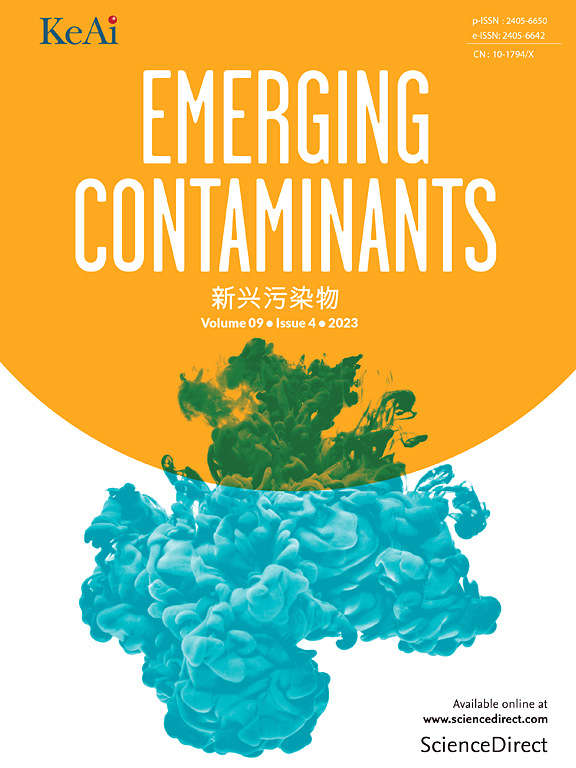使用本地和入侵物种作为生物监测仪的新兴关注污染物的发生,生物积累和生态风险评估
IF 6.9
2区 环境科学与生态学
Q1 ENVIRONMENTAL SCIENCES
引用次数: 0
摘要
传统上,监测新出现的关注污染物(CECs)的重点是评估它们在非生物隔间和本地鱼类中的发生情况。近年来,在环境质量研究中使用非本地物种已被证明是评估CECs暴露及其生态风险的关键工具。本研究提出利用不同的本地和入侵物种来评估地中海沿岸湿地的环境质量。在Albufera自然公园(西班牙)内的10个地点进行了生物监测评估,包括灌溉渠、湖泊和人工湿地。在该生态系统的主要入侵物种亚洲蛤、美洲红沼泽小龙虾和南瓜子太阳鱼中对171种CECs的生物积累进行了评价。此外,还与本地蛤蜊进行了比较分析,以验证入侵物种是否可以提供相同的信息。在至少一种被分析的物种中共检测到35个CECs。亚洲蛤显示出最多的检测到的化合物(23),以及最高的化学浓度,特别是药物。利用CECs内部浓度进行的生态风险评估也指出亚洲蛤是该地区最适合进行化学生物监测的物种。对计算生态风险贡献最大的化合物是舍曲林、氟西汀、特丁嗪、咖啡因和奥司他韦。在大多数暴露点,HI值显示高风险,表明来自本地和入侵物种的ce混合物的强大压力。本研究表明,入侵物种的化学物质浓度分析可以被认为是确定滨海湿地生态状况的补充工具。本文章由计算机程序翻译,如有差异,请以英文原文为准。

Occurrence, bioaccumulation, and ecological risk assessment of contaminants of emerging concern using native and invasive species as biomonitors
Traditionally, contaminants of emerging concern (CECs) monitoring have focused on assessing their occurrence in abiotic compartments and in native fish species. The use of non-native species in environmental quality studies has recently proven to be a key tool for evaluating the CECs exposure and their ecological risks. In this study, the use of different native and invasive species was proposed to assess the environmental quality of a coastal Mediterranean wetland. A biomonitoring assessment was conducted at ten locations within the Albufera Natural Park (Spain), including irrigation channels, the lake, and the artificial wetland. The bioaccumulation of 171 CECs was evaluated in the Asian clam, the American red swamp crayfish, and the pumpkinseed sunfish, which are primary invasive species in this ecosystem. Furthermore, a comparative analysis was done with the native clam to verify whether invasive species could provide equivalent information. A total of 35 CECs were detected in at least one of the species analyzed. The Asian clam exhibited the highest number of detected compounds (23), as well as the highest chemical concentrations, particularly for pharmaceuticals. The ecological risk assessment performed with internal concentrations of CECs also pointed at the Asian clam as the most suitable species for chemical biomonitoring in this area. The compounds that had the highest contribution to the calculated ecological risk were sertraline, fluoxetine, terbuthylazine, caffeine, and oseltamivir. At most exposure sites HI values revealed high risk, indicating strong pressure from mixtures of CEs for both native and invasive species. This study shows that the analysis of chemical concentrations in invasive species can be considered a complementary tool to determine the ecological status of coastal wetlands.
求助全文
通过发布文献求助,成功后即可免费获取论文全文。
去求助
来源期刊

Emerging Contaminants
Medicine-Public Health, Environmental and Occupational Health
CiteScore
10.00
自引率
6.70%
发文量
35
审稿时长
44 days
期刊介绍:
Emerging Contaminants is an outlet for world-leading research addressing problems associated with environmental contamination caused by emerging contaminants and their solutions. Emerging contaminants are defined as chemicals that are not currently (or have been only recently) regulated and about which there exist concerns regarding their impact on human or ecological health. Examples of emerging contaminants include disinfection by-products, pharmaceutical and personal care products, persistent organic chemicals, and mercury etc. as well as their degradation products. We encourage papers addressing science that facilitates greater understanding of the nature, extent, and impacts of the presence of emerging contaminants in the environment; technology that exploits original principles to reduce and control their environmental presence; as well as the development, implementation and efficacy of national and international policies to protect human health and the environment from emerging contaminants.
 求助内容:
求助内容: 应助结果提醒方式:
应助结果提醒方式:


